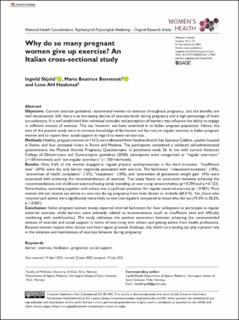| dc.contributor.author | Skjold, Ingvild | |
| dc.contributor.author | Benvenuti, Maria Beatrice | |
| dc.contributor.author | Haakstad, Lene Annette Hagen | |
| dc.date.accessioned | 2022-12-01T13:07:11Z | |
| dc.date.available | 2022-12-01T13:07:11Z | |
| dc.date.created | 2022-10-11T11:15:49Z | |
| dc.date.issued | 2022 | |
| dc.identifier.citation | Women’s Health. 2022, 18(2022), Artikkel 17455057221117967. | en_US |
| dc.identifier.issn | 1745-5057 | |
| dc.identifier.uri | https://hdl.handle.net/11250/3035383 | |
| dc.description | This article is distributed under the terms of the Creative Commons Attribution-NonCommercial 4.0 License (https://creativecommons.org/licenses/by-nc/4.0/) which permits non-commercial use, reproduction and distribution of the work without further permission provided the original work is attributed as specified on the SAGE and Open Access pages (https://us.sagepub.com/en-us/nam/open-access-at-sage). | en_US |
| dc.description.abstract | Objective: Current exercise guidelines recommend women to exercise throughout pregnancy, and the benefits are well documented. Still, there is an increasing decline of exercise levels during pregnancy and a high percentage of them are sedentary. It is well established that individual attitudes and perception of barriers may influence the ability to engage in sufficient amount of exercise. This has, however, not been examined in an Italian pregnant population. Hence, the aims of the present study were to increase knowledge of facilitators and barriers to regular exercise in Italian pregnant women and to report their social support in regard to maternal exercise.
Methods: Healthy, pregnant women (n = 513) were allocated from Fatebenefratelli San Giovanni Calibita, a public hospital in Rome, and four antenatal clinics in Rome and Modena. The participants completed a validated self-administrated questionnaire, the Physical Activity Pregnancy Questionnaire, in gestational week 36. In line with current American College of Obstetricians and Gynecologists guidelines (2020), participants were categorized as “regular exercisers” (⩾150 min/week) and “not regular exercisers” (< 150 min/week).
Results: Only 4.6% of the women engaged in regular physical activity/exercise in the third trimester. “Insufficient time” (54%) were the only barrier negatively associated with exercise. The facilitators “relaxation/recreation” (18%), “prevention of health complaints” (15%), “enjoyment” (10%), and “prevention of gestational weight gain” (4%) were associated with achieving the recommendations of exercise. This study found no association between achieving the recommendations and childhood exercise/having social modeling, or exercising network/milieu (p = 0.294 and p = 0.123). Nevertheless, exercising together with others was a significant predictor for regular maternal exercise (p < 0.001). Most women did not receive any advice on exercise during pregnancy from their doctor or midwife (60.0 %). Yet, those who received such advice were significantly more likely to exercise regularly compared to those who did not (75.0% vs 38.2%; p < 0.001).
Conclusion: Italian pregnant women mainly reported internal facilitators for their willingness to participate in regular maternal exercise, while barriers were primarily related to inconveniences (such as insufficient time and difficulty combining with work/studies). The study addresses the positive association between achieving the recommended amount of exercise and social support in terms of exercising with others and getting advice from health professions. Because women respect their doctor and have regular prenatal checkups, this health care setting can play a pivotal role in the initiation and maintenance of exercise behavior during pregnancy. | en_US |
| dc.language.iso | eng | en_US |
| dc.subject | barrier | en_US |
| dc.subject | exercise | en_US |
| dc.subject | facilitator | en_US |
| dc.subject | pregnancy | en_US |
| dc.subject | social support | en_US |
| dc.title | Why do so many pregnant women give up exercise?: An Italian cross-sectional study | en_US |
| dc.type | Peer reviewed | en_US |
| dc.type | Journal article | en_US |
| dc.description.version | publishedVersion | en_US |
| dc.rights.holder | © The Author(s) 2022 | en_US |
| dc.source.pagenumber | 10 | en_US |
| dc.source.volume | 18 | en_US |
| dc.source.journal | Women's Health. | en_US |
| dc.identifier.doi | 10.1177/17455057221117967 | |
| dc.identifier.cristin | 2060397 | |
| dc.description.localcode | Institutt for idrettsmedisinske fag / Department of Sports Medicine | en_US |
| dc.source.articlenumber | 17455057221117967 | en_US |
| cristin.ispublished | true | |
| cristin.fulltext | original | |
| cristin.qualitycode | 1 | |
